env.execute(“test Flink”)
以env.execute(“test Flink”) 为入口

public JobExecutionResult execute(String jobName) throws Exception {
Preconditions.checkNotNull(jobName, "Streaming Job name should not be null.");
// code 2 streamGraph
final StreamGraph streamGraph = getStreamGraph();
streamGraph.setJobName(jobName);
return execute(streamGraph);
}
getStreamGraph()
图转换的第一步,将code转换成streamGraph。
public StreamGraph getStreamGraph() {
return getStreamGraph(true);
}
public StreamGraph getStreamGraph(boolean clearTransformations) {
// StreamGraphGenerator.generate() 真正生成streamGraph的位置。
final StreamGraph streamGraph = getStreamGraphGenerator(transformations).generate();
if (clearTransformations) {
transformations.clear();
}
return streamGraph;
}
private StreamGraphGenerator getStreamGraphGenerator(List<Transformation<?>> transformations) {
if (transformations.size() <= 0) {
throw new IllegalStateException(
"No operators defined in streaming topology. Cannot execute.");
}
return new StreamGraphGenerator(transformations, config, checkpointCfg, configuration)
.setStateBackend(defaultStateBackend)
.setChangelogStateBackendEnabled(changelogStateBackendEnabled)
.setSavepointDir(defaultSavepointDirectory)
.setChaining(isChainingEnabled)
.setUserArtifacts(cacheFile)
.setTimeCharacteristic(timeCharacteristic)
.setDefaultBufferTimeout(bufferTimeout)
.setSlotSharingGroupResource(slotSharingGroupResources);
}
StreamGraphGenerator.generate()
public StreamGraph generate() {
streamGraph = new StreamGraph(executionConfig, checkpointConfig, savepointRestoreSettings);
streamGraph.setEnableCheckpointsAfterTasksFinish(
configuration.get(
ExecutionCheckpointingOptions.ENABLE_CHECKPOINTS_AFTER_TASKS_FINISH));
shouldExecuteInBatchMode = shouldExecuteInBatchMode();
configureStreamGraph(streamGraph);
alreadyTransformed = new HashMap<>();
for (Transformation<?> transformation : transformations) {
transform(transformation);
}
streamGraph.setSlotSharingGroupResource(slotSharingGroupResources);
setFineGrainedGlobalStreamExchangeMode(streamGraph);
for (StreamNode node : streamGraph.getStreamNodes()) {
if (node.getInEdges().stream().anyMatch(this::shouldDisableUnalignedCheckpointing)) {
for (StreamEdge edge : node.getInEdges()) {
edge.setSupportsUnalignedCheckpoints(false);
}
}
}
final StreamGraph builtStreamGraph = streamGraph;
alreadyTransformed.clear();
alreadyTransformed = null;
streamGraph = null;
return builtStreamGraph;
}
transformations
这部分理解一下transformation的由来。
final StreamGraph streamGraph = getStreamGraphGenerator(transformations).generate();
// StreamExecutionEnvironment中声明变量。
protected final List<Transformation<?>> transformations = new ArrayList<>();
// 这段代码是操作添加转换算子的, 我们要看下图所示调用这个方法的类。
@Internal
public void addOperator(Transformation<?> transformation) {
Preconditions.checkNotNull(transformation, "transformation must not be null.");
this.transformations.add(transformation);
}
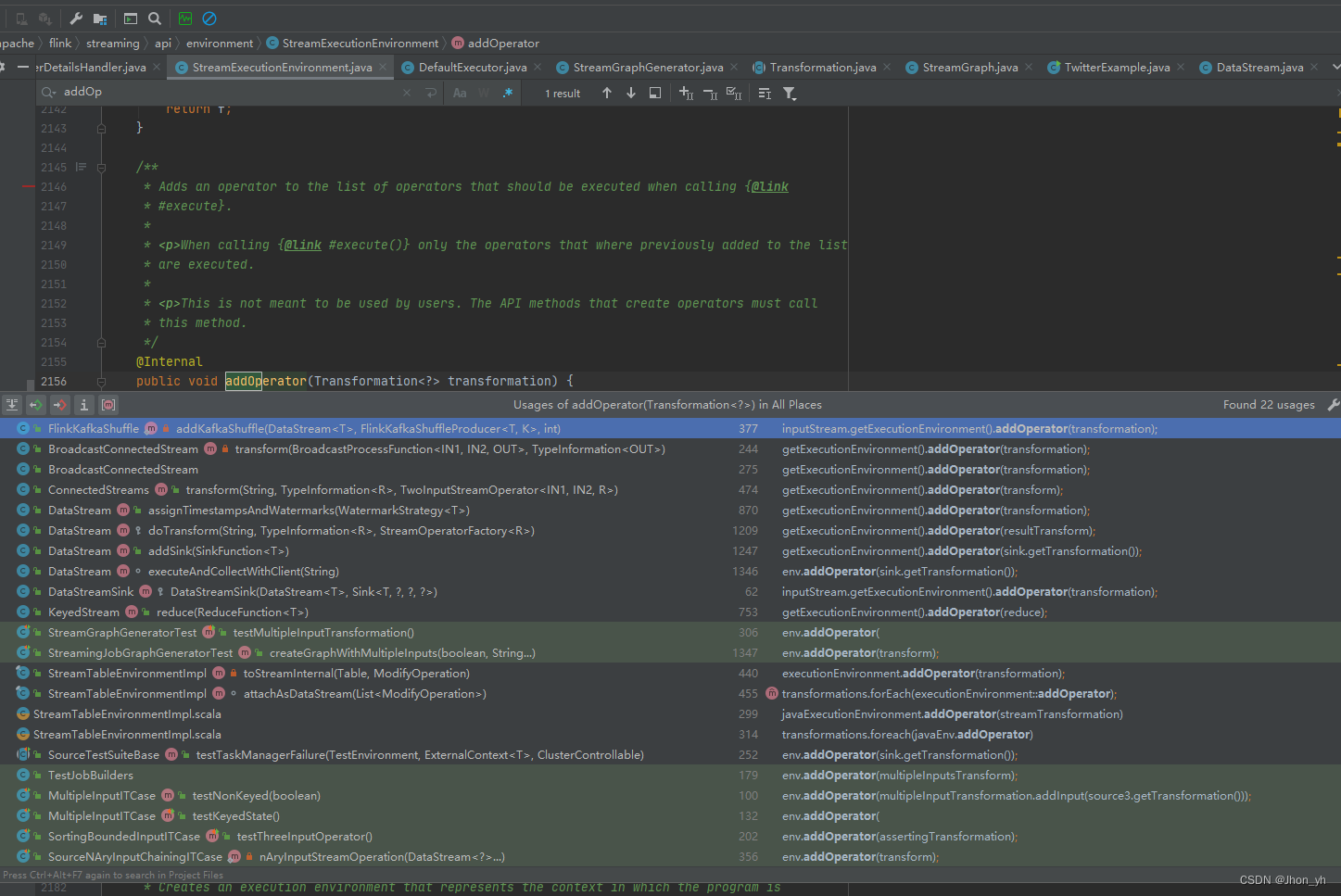
transformation 有如下实现。
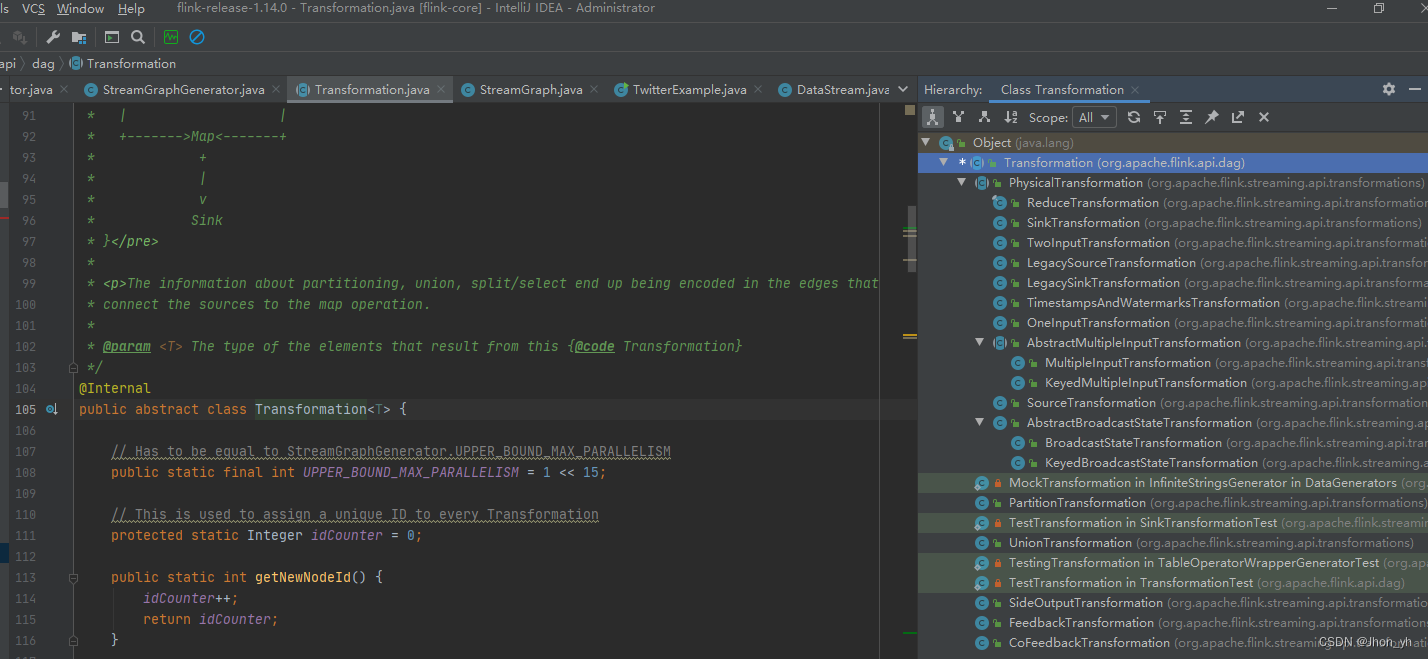
我们以map算子为例,看transformations转换的过程。关键代码如下。
public <R> SingleOutputStreamOperator<R> map(MapFunction<T, R> mapper) {
TypeInformation<R> outType =
TypeExtractor.getMapReturnTypes(
clean(mapper), getType(), Utils.getCallLocationName(), true);
// map方法
return map(mapper, outType);
}
//
public <R> SingleOutputStreamOperator<R> map(
MapFunction<T, R> mapper, TypeInformation<R> outputType) {
return transform("Map", outputType, new StreamMap<>(clean(mapper)));
}
public <R> SingleOutputStreamOperator<R> transform(
String operatorName,
TypeInformation<R> outTypeInfo,
OneInputStreamOperator<T, R> operator) {
return doTransform(operatorName, outTypeInfo, SimpleOperatorFactory.of(operator));
}
// 最后这个方法完成了 算子的转换和dataStream的返回。
protected <R> SingleOutputStreamOperator<R> doTransform(
String operatorName,
TypeInformation<R> outTypeInfo,
StreamOperatorFactory<R> operatorFactory) {
// read the output type of the input Transform to coax out errors about MissingTypeInfo
transformation.getOutputType();
// 下面生成了transform
OneInputTransformation<T, R> resultTransform =
new OneInputTransformation<>(
this.transformation,
operatorName,
operatorFactory,
outTypeInfo,
environment.getParallelism());
@SuppressWarnings({"unchecked", "rawtypes"})
SingleOutputStreamOperator<R> returnStream =
new SingleOutputStreamOperator(environment, resultTransform);
// 下面将transform添加到了 transformations中
getExecutionEnvironment().addOperator(resultTransform);
return returnStream;
}
execute(StreamGraph streamGraph)
public JobExecutionResult execute(StreamGraph streamGraph) throws Exception {
final JobClient jobClient = executeAsync(streamGraph);
try {
final JobExecutionResult jobExecutionResult;
if (configuration.getBoolean(DeploymentOptions.ATTACHED)) {
jobExecutionResult = jobClient.getJobExecutionResult().get();
} else {
jobExecutionResult = new DetachedJobExecutionResult(jobClient.getJobID());
}
jobListeners.forEach(
jobListener -> jobListener.onJobExecuted(jobExecutionResult, null));
return jobExecutionResult;
} catch (Throwable t) {
// get() on the JobExecutionResult Future will throw an ExecutionException. This
// behaviour was largely not there in Flink versions before the PipelineExecutor
// refactoring so we should strip that exception.
Throwable strippedException = ExceptionUtils.stripExecutionException(t);
jobListeners.forEach(
jobListener -> {
jobListener.onJobExecuted(null, strippedException);
});
ExceptionUtils.rethrowException(strippedException);
// never reached, only make javac happy
return null;
}
}
executeAsync(jobGraph)
这段代码我们主要看
CompletableFuture jobClientFuture =
executorFactory
.getExecutor(configuration) //获取执行器
== .execute(streamGraph, configuration, userClassloader); //和这里==
getExecutor()
通过下图我们可以看到常用的executor,拿我们生产中用到的YarnJobClusterFactor来看。

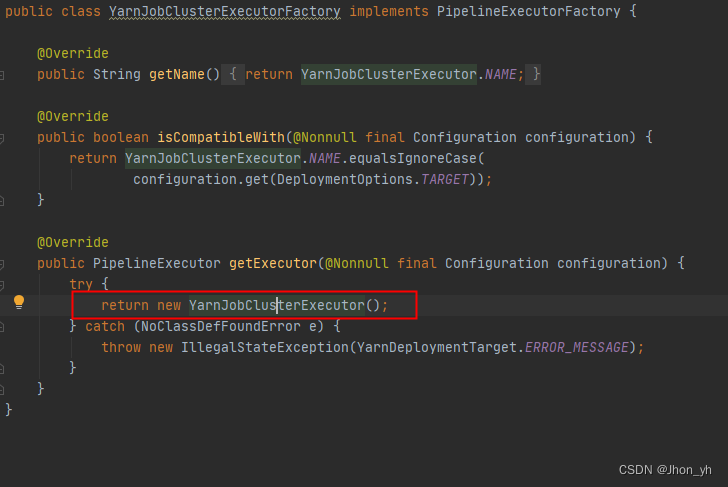
public JobClient executeAsync(StreamGraph streamGraph) throws Exception {
checkNotNull(streamGraph, "StreamGraph cannot be null.");
checkNotNull(
configuration.get(DeploymentOptions.TARGET),
"No execution.target specified in your configuration file.");
final PipelineExecutorFactory executorFactory =
executorServiceLoader.getExecutorFactory(configuration);
checkNotNull(
executorFactory,
"Cannot find compatible factory for specified execution.target (=%s)",
configuration.get(DeploymentOptions.TARGET));
CompletableFuture<JobClient> jobClientFuture =
executorFactory
.getExecutor(configuration)
.execute(streamGraph, configuration, userClassloader);
try {
JobClient jobClient = jobClientFuture.get();
jobListeners.forEach(jobListener -> jobListener.onJobSubmitted(jobClient, null));
return jobClient;
} catch (ExecutionException executionException) {
final Throwable strippedException =
ExceptionUtils.stripExecutionException(executionException);
jobListeners.forEach(
jobListener -> jobListener.onJobSubmitted(null, strippedException));
throw new FlinkException(
String.format("Failed to execute job '%s'.", streamGraph.getJobName()),
strippedException);
}
}
@Internal
public class YarnJobClusterExecutorFactory implements PipelineExecutorFactory {
@Override
public String getName() {
return YarnJobClusterExecutor.NAME;
}
@Override
public boolean isCompatibleWith(@Nonnull final Configuration configuration) {
return YarnJobClusterExecutor.NAME.equalsIgnoreCase(
configuration.get(DeploymentOptions.TARGET));
}
@Override
public PipelineExecutor getExecutor(@Nonnull final Configuration configuration) {
try {
//返回yarnJobClusterExecutor执行器。
return new YarnJobClusterExecutor();
} catch (NoClassDefFoundError e) {
throw new IllegalStateException(YarnDeploymentTarget.ERROR_MESSAGE);
}
}
}
execute(streamGraph, configuration, userClassloader)
通过下图我们可以看到,实现类有Yarn,k8s等,我们继续看AbstractJobClusterExecutor
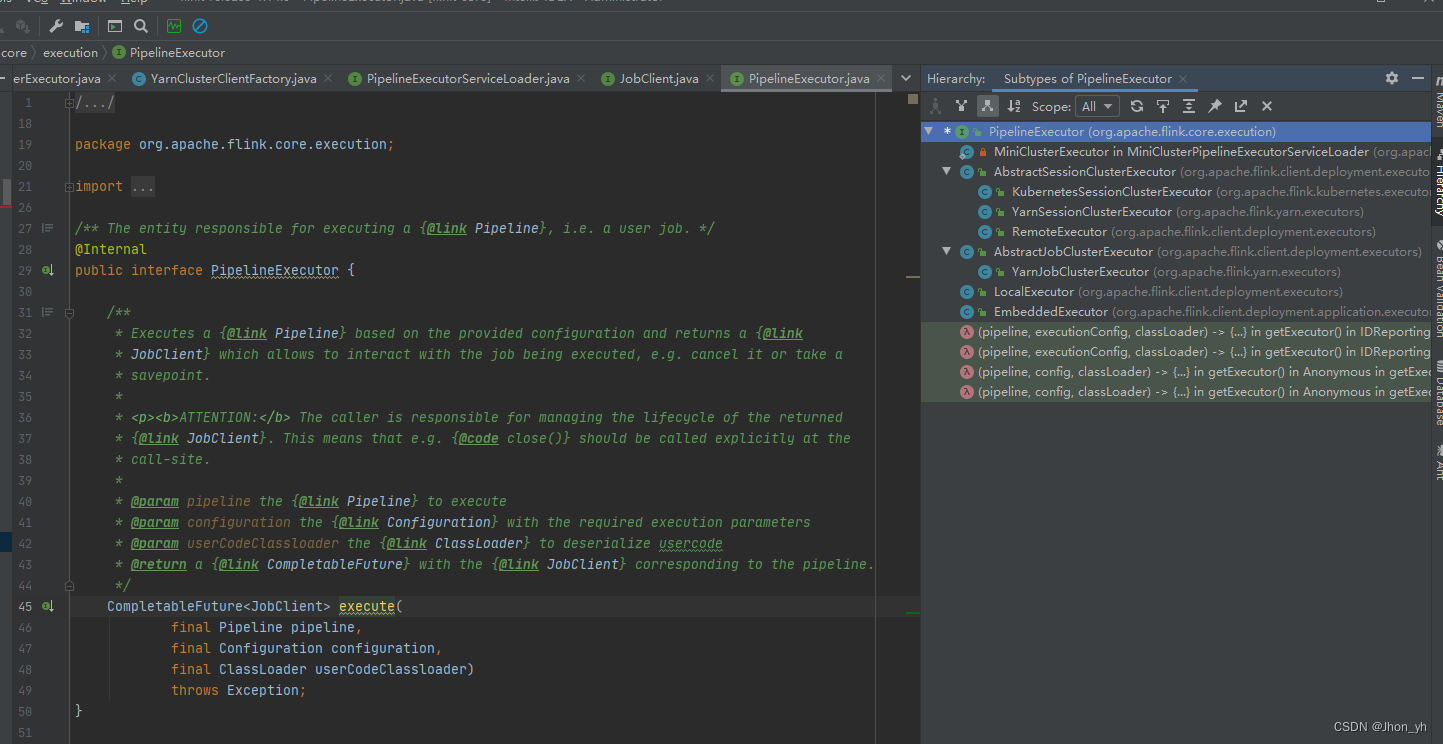
@Override
public CompletableFuture<JobClient> execute(
@Nonnull final Pipeline pipeline,
@Nonnull final Configuration configuration,
@Nonnull final ClassLoader userCodeClassloader)
throws Exception {
final JobGraph jobGraph = PipelineExecutorUtils.getJobGraph(pipeline, configuration);
try (final ClusterDescriptor<ClusterID> clusterDescriptor =
//这里初始化了 yarnClient 如下图。
clusterClientFactory.createClusterDescriptor(configuration)) {
final ExecutionConfigAccessor configAccessor =
ExecutionConfigAccessor.fromConfiguration(configuration);
final ClusterSpecification clusterSpecification =
clusterClientFactory.getClusterSpecification(configuration);
final ClusterClientProvider<ClusterID> clusterClientProvider =
clusterDescriptor.deployJobCluster(
clusterSpecification, jobGraph, configAccessor.getDetachedMode());
LOG.info("Job has been submitted with JobID " + jobGraph.getJobID());
return CompletableFuture.completedFuture(
new ClusterClientJobClientAdapter<>(
clusterClientProvider, jobGraph.getJobID(), userCodeClassloader));
}
}
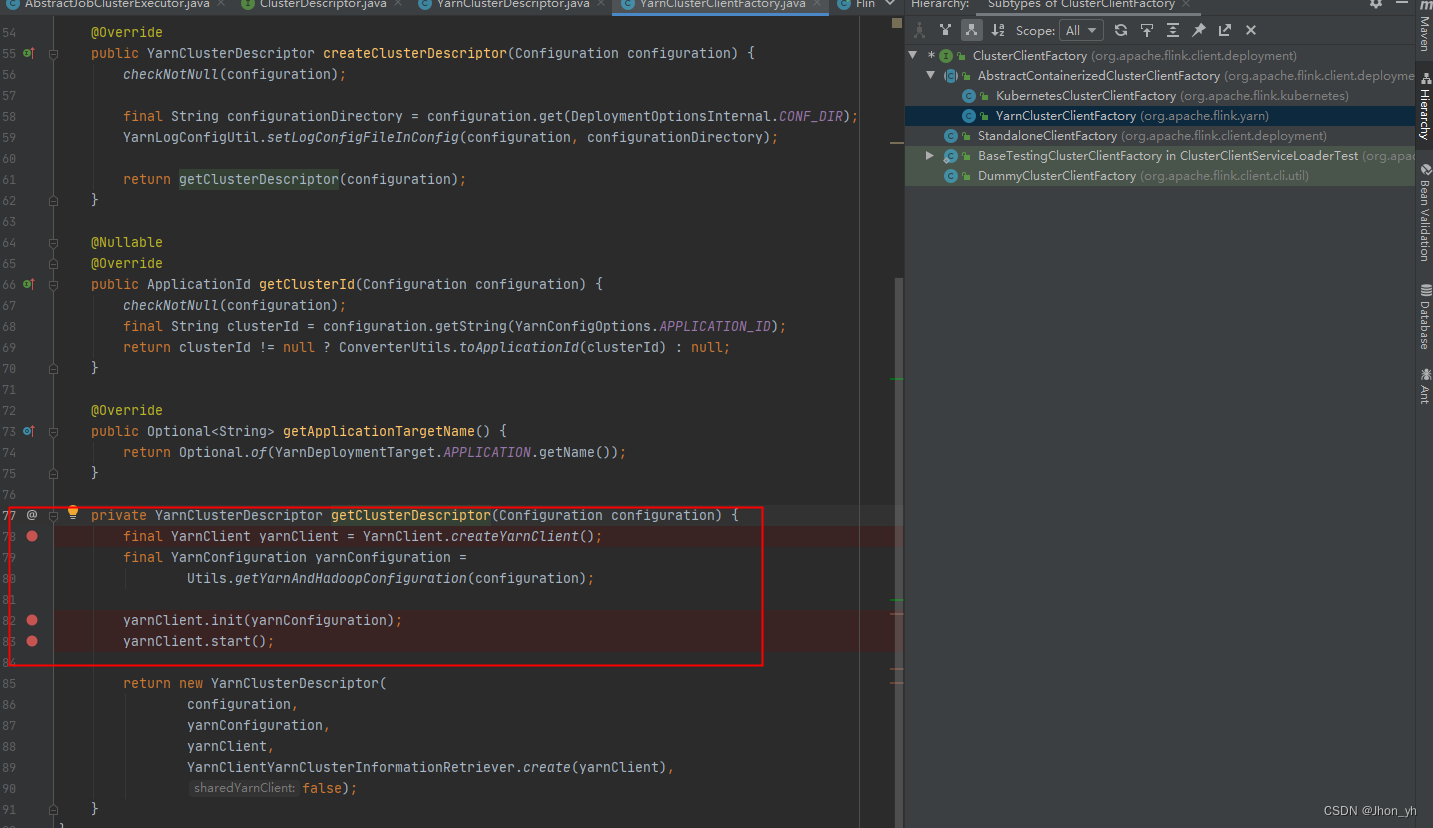
deployJobCluster()
如下图,找到实现类,接下来我们看 return deployInternal(…) 方法
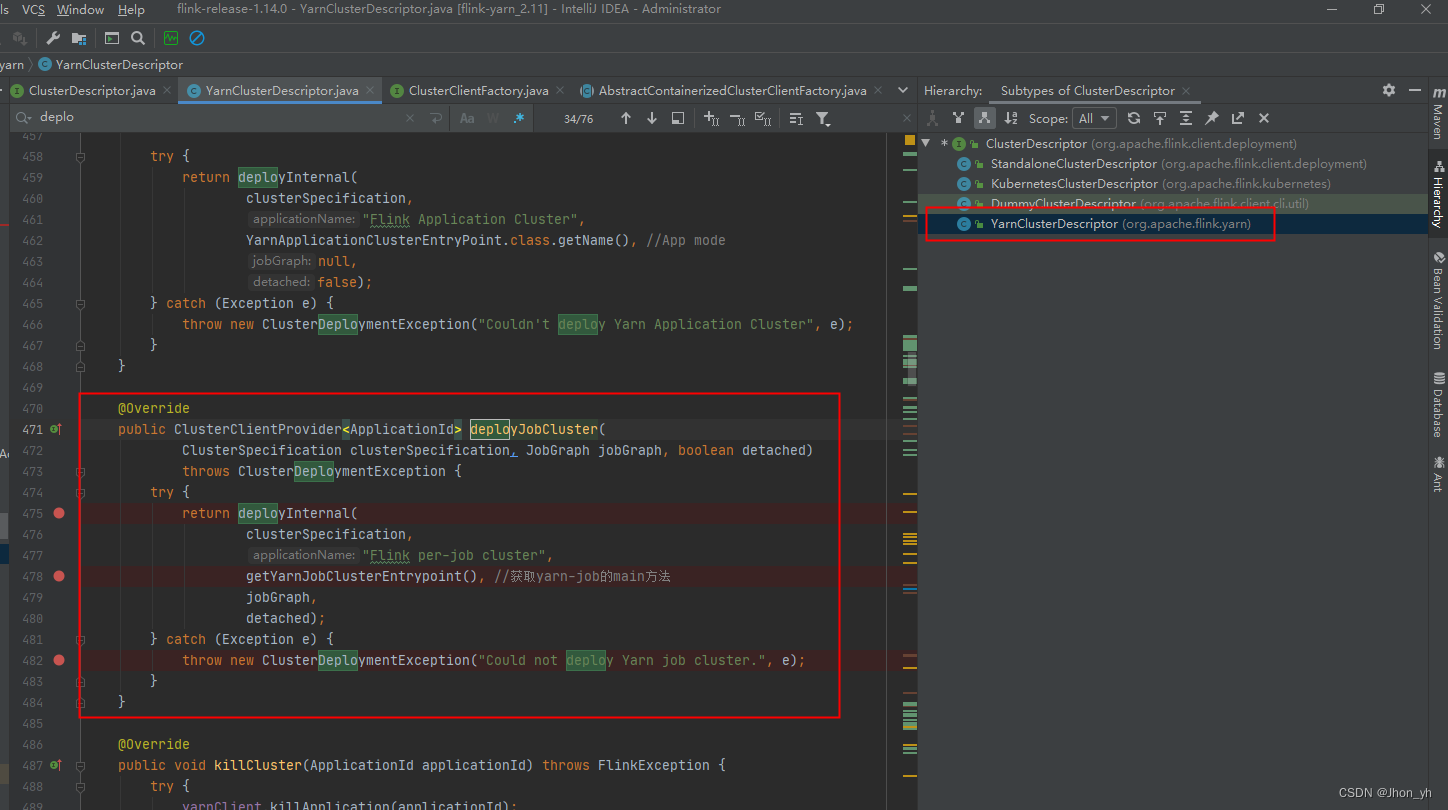
@Override
public ClusterClientProvider<ApplicationId> deployJobCluster(
ClusterSpecification clusterSpecification, JobGraph jobGraph, boolean detached)
throws ClusterDeploymentException {
try {
return deployInternal(
clusterSpecification,
"Flink per-job cluster",
getYarnJobClusterEntrypoint(), //获取yarn-job的main方法
jobGraph,
detached);
} catch (Exception e) {
throw new ClusterDeploymentException("Could not deploy Yarn job cluster.", e);
}
}
return deployInternal(
getYarnJobClusterEntrypoint() 这个方法 返回类名
**YarnJobClusterEntrypoint.class.getName()**这个类在后面提交任务的时候会用到。
deployInternal()
这段代码比较长完成的也比较多,在代码里面注释一下,直接看代码
private ClusterClientProvider<ApplicationId> deployInternal(
ClusterSpecification clusterSpecification,
String applicationName,
String yarnClusterEntrypoint,
@Nullable JobGraph jobGraph,
boolean detached)
throws Exception {
//获取当前的用户
final UserGroupInformation currentUser = UserGroupInformation.getCurrentUser();
//是否开启kerberos认证
if (HadoopUtils.isKerberosSecurityEnabled(currentUser)) {
boolean useTicketCache =
flinkConfiguration.getBoolean(SecurityOptions.KERBEROS_LOGIN_USETICKETCACHE);
if (!HadoopUtils.areKerberosCredentialsValid(currentUser, useTicketCache)) {
throw new RuntimeException(
"Hadoop security with Kerberos is enabled but the login user "
+ "does not have Kerberos credentials or delegation tokens!");
}
final boolean fetchToken =
flinkConfiguration.getBoolean(SecurityOptions.KERBEROS_FETCH_DELEGATION_TOKEN);
final boolean yarnAccessFSEnabled =
!CollectionUtil.isNullOrEmpty(
flinkConfiguration.get(YarnConfigOptions.YARN_ACCESS));
if (!fetchToken && yarnAccessFSEnabled) {
throw new IllegalConfigurationException(
String.format(
"When %s is disabled, %s must be disabled as well.",
SecurityOptions.KERBEROS_FETCH_DELEGATION_TOKEN.key(),
YarnConfigOptions.YARN_ACCESS.key()));
}
}
// 校验资源
isReadyForDeployment(clusterSpecification);
// ------------------ Check if the specified queue exists --------------------
// 队列
checkYarnQueues(yarnClient);
// ------------------ Check if the YARN ClusterClient has the requested resources
// --------------
// Create application via yarnClient
final YarnClientApplication yarnApplication = yarnClient.createApplication();
final GetNewApplicationResponse appResponse = yarnApplication.getNewApplicationResponse();
Resource maxRes = appResponse.getMaximumResourceCapability();
final ClusterResourceDescription freeClusterMem;
try {
freeClusterMem = getCurrentFreeClusterResources(yarnClient);
} catch (YarnException | IOException e) {
failSessionDuringDeployment(yarnClient, yarnApplication);
throw new YarnDeploymentException(
"Could not retrieve information about free cluster resources.", e);
}
final int yarnMinAllocationMB =
yarnConfiguration.getInt(
YarnConfiguration.RM_SCHEDULER_MINIMUM_ALLOCATION_MB,
YarnConfiguration.DEFAULT_RM_SCHEDULER_MINIMUM_ALLOCATION_MB);
if (yarnMinAllocationMB <= 0) {
throw new YarnDeploymentException(
"The minimum allocation memory "
+ "("
+ yarnMinAllocationMB
+ " MB) configured via '"
+ YarnConfiguration.RM_SCHEDULER_MINIMUM_ALLOCATION_MB
+ "' should be greater than 0.");
}
final ClusterSpecification validClusterSpecification;
try {
validClusterSpecification =
validateClusterResources(
clusterSpecification, yarnMinAllocationMB, maxRes, freeClusterMem);
} catch (YarnDeploymentException yde) {
failSessionDuringDeployment(yarnClient, yarnApplication);
throw yde;
}
LOG.info("Cluster specification: {}", validClusterSpecification);
final ClusterEntrypoint.ExecutionMode executionMode =
detached
? ClusterEntrypoint.ExecutionMode.DETACHED
: ClusterEntrypoint.ExecutionMode.NORMAL;
flinkConfiguration.setString(
ClusterEntrypoint.INTERNAL_CLUSTER_EXECUTION_MODE, executionMode.toString());
// 启动appMaster
ApplicationReport report =
startAppMaster(
flinkConfiguration,
applicationName,
yarnClusterEntrypoint,
jobGraph,
yarnClient,
yarnApplication,
validClusterSpecification);
// print the application id for user to cancel themselves.
if (detached) {
final ApplicationId yarnApplicationId = report.getApplicationId();
logDetachedClusterInformation(yarnApplicationId, LOG);
}
setClusterEntrypointInfoToConfig(report);
return () -> {
try {
return new RestClusterClient<>(flinkConfiguration, report.getApplicationId());
} catch (Exception e) {
throw new RuntimeException("Error while creating RestClusterClient.", e);
}
};
}
startAppMaster
启动appMaster过程中,主要作用初始化yarn提交上下文,上传依赖的jar,jobGraph写出到临时路径,生成临时配置文件==(appId-flink-conf.yaml)==,kerberos信息, JobManager描述信息, Container上下文,提交任务yarnClient.submitApplication(appContext);,获取任务提交的信息,返回report。
ApplicationReport report =
startAppMaster(
flinkConfiguration,
applicationName,
yarnClusterEntrypoint,
jobGraph,
yarnClient,
yarnApplication,
validClusterSpecification);
private ApplicationReport startAppMaster(
Configuration configuration,
String applicationName,
String yarnClusterEntrypoint,
JobGraph jobGraph,
YarnClient yarnClient,
YarnClientApplication yarnApplication,
ClusterSpecification clusterSpecification)
throws Exception {
// ------------------ Initialize the file systems -------------------------
org.apache.flink.core.fs.FileSystem.initialize(
configuration, PluginUtils.createPluginManagerFromRootFolder(configuration));
// 获取fileSystem
final FileSystem fs = FileSystem.get(yarnConfiguration);
// hard coded check for the GoogleHDFS client because its not overriding the getScheme()
// method.
if (!fs.getClass().getSimpleName().equals("GoogleHadoopFileSystem")
&& fs.getScheme().startsWith("file")) {
LOG.warn(
"The file system scheme is '"
+ fs.getScheme()
+ "'. This indicates that the "
+ "specified Hadoop configuration path is wrong and the system is using the default Hadoop configuration values."
+ "The Flink YARN client needs to store its files in a distributed file system");
}
//获取提交上下文。
ApplicationSubmissionContext appContext = yarnApplication.getApplicationSubmissionContext();
//
final List<Path> providedLibDirs =
Utils.getQualifiedRemoteSharedPaths(configuration, yarnConfiguration);
final YarnApplicationFileUploader fileUploader =
YarnApplicationFileUploader.from(
fs,
getStagingDir(fs),
providedLibDirs,
appContext.getApplicationId(),
getFileReplication());
// The files need to be shipped and added to classpath.
Set<File> systemShipFiles = new HashSet<>(shipFiles.size());
for (File file : shipFiles) {
systemShipFiles.add(file.getAbsoluteFile());
}
final String logConfigFilePath =
configuration.getString(YarnConfigOptionsInternal.APPLICATION_LOG_CONFIG_FILE);
if (logConfigFilePath != null) {
systemShipFiles.add(new File(logConfigFilePath));
}
// Set-up ApplicationSubmissionContext for the application
final ApplicationId appId = appContext.getApplicationId();
// ------------------ Add Zookeeper namespace to local flinkConfiguraton ------
setHAClusterIdIfNotSet(configuration, appId);
if (HighAvailabilityMode.isHighAvailabilityModeActivated(configuration)) {
// activate re-execution of failed applications
appContext.setMaxAppAttempts(
configuration.getInteger(
YarnConfigOptions.APPLICATION_ATTEMPTS.key(),
YarnConfiguration.DEFAULT_RM_AM_MAX_ATTEMPTS));
activateHighAvailabilitySupport(appContext);
} else {
// set number of application retries to 1 in the default case
appContext.setMaxAppAttempts(
configuration.getInteger(YarnConfigOptions.APPLICATION_ATTEMPTS.key(), 1));
}
final Set<Path> userJarFiles = new HashSet<>();
if (jobGraph != null) {
userJarFiles.addAll(
jobGraph.getUserJars().stream()
.map(f -> f.toUri())
.map(Path::new)
.collect(Collectors.toSet()));
}
final List<URI> jarUrls =
ConfigUtils.decodeListFromConfig(configuration, PipelineOptions.JARS, URI::create);
if (jarUrls != null
&& YarnApplicationClusterEntryPoint.class.getName().equals(yarnClusterEntrypoint)) {
userJarFiles.addAll(jarUrls.stream().map(Path::new).collect(Collectors.toSet()));
}
// only for per job mode
if (jobGraph != null) {
for (Map.Entry<String, DistributedCache.DistributedCacheEntry> entry :
jobGraph.getUserArtifacts().entrySet()) {
// only upload local files
if (!Utils.isRemotePath(entry.getValue().filePath)) {
Path localPath = new Path(entry.getValue().filePath);
Tuple2<Path, Long> remoteFileInfo =
fileUploader.uploadLocalFileToRemote(localPath, entry.getKey());
jobGraph.setUserArtifactRemotePath(
entry.getKey(), remoteFileInfo.f0.toString());
}
}
jobGraph.writeUserArtifactEntriesToConfiguration();
}
if (providedLibDirs == null || providedLibDirs.isEmpty()) {
addLibFoldersToShipFiles(systemShipFiles);
}
// Register all files in provided lib dirs as local resources with public visibility
// and upload the remaining dependencies as local resources with APPLICATION visibility.
final List<String> systemClassPaths = fileUploader.registerProvidedLocalResources();
final List<String> uploadedDependencies =
fileUploader.registerMultipleLocalResources(
systemShipFiles.stream()
.map(e -> new Path(e.toURI()))
.collect(Collectors.toSet()),
Path.CUR_DIR,
LocalResourceType.FILE);
systemClassPaths.addAll(uploadedDependencies);
// upload and register ship-only files
// Plugin files only need to be shipped and should not be added to classpath.
if (providedLibDirs == null || providedLibDirs.isEmpty()) {
Set<File> shipOnlyFiles = new HashSet<>();
addPluginsFoldersToShipFiles(shipOnlyFiles);
fileUploader.registerMultipleLocalResources(
shipOnlyFiles.stream()
.map(e -> new Path(e.toURI()))
.collect(Collectors.toSet()),
Path.CUR_DIR,
LocalResourceType.FILE);
}
if (!shipArchives.isEmpty()) {
fileUploader.registerMultipleLocalResources(
shipArchives.stream().map(e -> new Path(e.toURI())).collect(Collectors.toSet()),
Path.CUR_DIR,
LocalResourceType.ARCHIVE);
}
// Upload and register user jars
final List<String> userClassPaths =
fileUploader.registerMultipleLocalResources(
userJarFiles,
userJarInclusion == YarnConfigOptions.UserJarInclusion.DISABLED
? ConfigConstants.DEFAULT_FLINK_USR_LIB_DIR
: Path.CUR_DIR,
LocalResourceType.FILE);
if (userJarInclusion == YarnConfigOptions.UserJarInclusion.ORDER) {
systemClassPaths.addAll(userClassPaths);
}
// normalize classpath by sorting
Collections.sort(systemClassPaths);
Collections.sort(userClassPaths);
// classpath assembler
StringBuilder classPathBuilder = new StringBuilder();
if (userJarInclusion == YarnConfigOptions.UserJarInclusion.FIRST) {
for (String userClassPath : userClassPaths) {
classPathBuilder.append(userClassPath).append(File.pathSeparator);
}
}
for (String classPath : systemClassPaths) {
classPathBuilder.append(classPath).append(File.pathSeparator);
}
// Setup jar for ApplicationMaster
final YarnLocalResourceDescriptor localResourceDescFlinkJar =
fileUploader.uploadFlinkDist(flinkJarPath);
classPathBuilder
.append(localResourceDescFlinkJar.getResourceKey())
.append(File.pathSeparator);
// write job graph to tmp file and add it to local resource
// TODO: server use user main method to generate job graph
if (jobGraph != null) {
File tmpJobGraphFile = null;
try {
tmpJobGraphFile = File.createTempFile(appId.toString(), null);
try (FileOutputStream output = new FileOutputStream(tmpJobGraphFile);
ObjectOutputStream obOutput = new ObjectOutputStream(output)) {
obOutput.writeObject(jobGraph);
}
final String jobGraphFilename = "job.graph";
configuration.setString(JOB_GRAPH_FILE_PATH, jobGraphFilename);
fileUploader.registerSingleLocalResource(
jobGraphFilename,
new Path(tmpJobGraphFile.toURI()),
"",
LocalResourceType.FILE,
true,
false);
classPathBuilder.append(jobGraphFilename).append(File.pathSeparator);
} catch (Exception e) {
LOG.warn("Add job graph to local resource fail.");
throw e;
} finally {
if (tmpJobGraphFile != null && !tmpJobGraphFile.delete()) {
LOG.warn("Fail to delete temporary file {}.", tmpJobGraphFile.toPath());
}
}
}
// Upload the flink configuration
// write out configuration file
File tmpConfigurationFile = null;
try {
tmpConfigurationFile = File.createTempFile(appId + "-flink-conf.yaml", null);
BootstrapTools.writeConfiguration(configuration, tmpConfigurationFile);
String flinkConfigKey = "flink-conf.yaml";
fileUploader.registerSingleLocalResource(
flinkConfigKey,
new Path(tmpConfigurationFile.getAbsolutePath()),
"",
LocalResourceType.FILE,
true,
true);
classPathBuilder.append("flink-conf.yaml").append(File.pathSeparator);
} finally {
if (tmpConfigurationFile != null && !tmpConfigurationFile.delete()) {
LOG.warn("Fail to delete temporary file {}.", tmpConfigurationFile.toPath());
}
}
if (userJarInclusion == YarnConfigOptions.UserJarInclusion.LAST) {
for (String userClassPath : userClassPaths) {
classPathBuilder.append(userClassPath).append(File.pathSeparator);
}
}
// To support Yarn Secure Integration Test Scenario
// In Integration test setup, the Yarn containers created by YarnMiniCluster does not have
// the Yarn site XML
// and KRB5 configuration files. We are adding these files as container local resources for
// the container
// applications (JM/TMs) to have proper secure cluster setup
Path remoteYarnSiteXmlPath = null;
if (System.getenv("IN_TESTS") != null) {
File f = new File(System.getenv("YARN_CONF_DIR"), Utils.YARN_SITE_FILE_NAME);
LOG.info(
"Adding Yarn configuration {} to the AM container local resource bucket",
f.getAbsolutePath());
Path yarnSitePath = new Path(f.getAbsolutePath());
remoteYarnSiteXmlPath =
fileUploader
.registerSingleLocalResource(
Utils.YARN_SITE_FILE_NAME,
yarnSitePath,
"",
LocalResourceType.FILE,
false,
false)
.getPath();
if (System.getProperty("java.security.krb5.conf") != null) {
configuration.set(
SecurityOptions.KERBEROS_KRB5_PATH,
System.getProperty("java.security.krb5.conf"));
}
}
Path remoteKrb5Path = null;
boolean hasKrb5 = false;
String krb5Config = configuration.get(SecurityOptions.KERBEROS_KRB5_PATH);
if (!StringUtils.isNullOrWhitespaceOnly(krb5Config)) {
final File krb5 = new File(krb5Config);
LOG.info(
"Adding KRB5 configuration {} to the AM container local resource bucket",
krb5.getAbsolutePath());
final Path krb5ConfPath = new Path(krb5.getAbsolutePath());
remoteKrb5Path =
fileUploader
.registerSingleLocalResource(
Utils.KRB5_FILE_NAME,
krb5ConfPath,
"",
LocalResourceType.FILE,
false,
false)
.getPath();
hasKrb5 = true;
}
Path remotePathKeytab = null;
String localizedKeytabPath = null;
String keytab = configuration.getString(SecurityOptions.KERBEROS_LOGIN_KEYTAB);
if (keytab != null) {
boolean localizeKeytab =
flinkConfiguration.getBoolean(YarnConfigOptions.SHIP_LOCAL_KEYTAB);
localizedKeytabPath =
flinkConfiguration.getString(YarnConfigOptions.LOCALIZED_KEYTAB_PATH);
if (localizeKeytab) {
// Localize the keytab to YARN containers via local resource.
LOG.info("Adding keytab {} to the AM container local resource bucket", keytab);
remotePathKeytab =
fileUploader
.registerSingleLocalResource(
localizedKeytabPath,
new Path(keytab),
"",
LocalResourceType.FILE,
false,
false)
.getPath();
} else {
// // Assume Keytab is pre-installed in the container.
localizedKeytabPath =
flinkConfiguration.getString(YarnConfigOptions.LOCALIZED_KEYTAB_PATH);
}
}
final JobManagerProcessSpec processSpec =
JobManagerProcessUtils.processSpecFromConfigWithNewOptionToInterpretLegacyHeap(
flinkConfiguration, JobManagerOptions.TOTAL_PROCESS_MEMORY);
final ContainerLaunchContext amContainer =
setupApplicationMasterContainer(yarnClusterEntrypoint, hasKrb5, processSpec);
// setup security tokens
if (UserGroupInformation.isSecurityEnabled()) {
// set HDFS delegation tokens when security is enabled
LOG.info("Adding delegation token to the AM container.");
final List<Path> pathsToObtainToken = new ArrayList<>();
boolean fetchToken =
configuration.getBoolean(SecurityOptions.KERBEROS_FETCH_DELEGATION_TOKEN);
if (fetchToken) {
List<Path> yarnAccessList =
ConfigUtils.decodeListFromConfig(
configuration, YarnConfigOptions.YARN_ACCESS, Path::new);
pathsToObtainToken.addAll(yarnAccessList);
pathsToObtainToken.addAll(fileUploader.getRemotePaths());
}
Utils.setTokensFor(amContainer, pathsToObtainToken, yarnConfiguration, fetchToken);
}
amContainer.setLocalResources(fileUploader.getRegisteredLocalResources());
fileUploader.close();
// Setup CLASSPATH and environment variables for ApplicationMaster
final Map<String, String> appMasterEnv = new HashMap<>();
// set user specified app master environment variables
appMasterEnv.putAll(
ConfigurationUtils.getPrefixedKeyValuePairs(
ResourceManagerOptions.CONTAINERIZED_MASTER_ENV_PREFIX, configuration));
// set Flink app class path
appMasterEnv.put(YarnConfigKeys.ENV_FLINK_CLASSPATH, classPathBuilder.toString());
// set Flink on YARN internal configuration values
appMasterEnv.put(YarnConfigKeys.FLINK_DIST_JAR, localResourceDescFlinkJar.toString());
appMasterEnv.put(YarnConfigKeys.ENV_APP_ID, appId.toString());
appMasterEnv.put(YarnConfigKeys.ENV_CLIENT_HOME_DIR, fileUploader.getHomeDir().toString());
appMasterEnv.put(
YarnConfigKeys.ENV_CLIENT_SHIP_FILES,
encodeYarnLocalResourceDescriptorListToString(
fileUploader.getEnvShipResourceList()));
appMasterEnv.put(
YarnConfigKeys.FLINK_YARN_FILES,
fileUploader.getApplicationDir().toUri().toString());
// https://github.com/apache/hadoop/blob/trunk/hadoop-yarn-project/hadoop-yarn/hadoop-yarn-site/src/site/markdown/YarnApplicationSecurity.md#identity-on-an-insecure-cluster-hadoop_user_name
appMasterEnv.put(
YarnConfigKeys.ENV_HADOOP_USER_NAME,
UserGroupInformation.getCurrentUser().getUserName());
if (localizedKeytabPath != null) {
appMasterEnv.put(YarnConfigKeys.LOCAL_KEYTAB_PATH, localizedKeytabPath);
String principal = configuration.getString(SecurityOptions.KERBEROS_LOGIN_PRINCIPAL);
appMasterEnv.put(YarnConfigKeys.KEYTAB_PRINCIPAL, principal);
if (remotePathKeytab != null) {
appMasterEnv.put(YarnConfigKeys.REMOTE_KEYTAB_PATH, remotePathKeytab.toString());
}
}
// To support Yarn Secure Integration Test Scenario
if (remoteYarnSiteXmlPath != null) {
appMasterEnv.put(
YarnConfigKeys.ENV_YARN_SITE_XML_PATH, remoteYarnSiteXmlPath.toString());
}
if (remoteKrb5Path != null) {
appMasterEnv.put(YarnConfigKeys.ENV_KRB5_PATH, remoteKrb5Path.toString());
}
// set classpath from YARN configuration
Utils.setupYarnClassPath(yarnConfiguration, appMasterEnv);
amContainer.setEnvironment(appMasterEnv);
// Set up resource type requirements for ApplicationMaster
Resource capability = Records.newRecord(Resource.class);
capability.setMemory(clusterSpecification.getMasterMemoryMB());
capability.setVirtualCores(
flinkConfiguration.getInteger(YarnConfigOptions.APP_MASTER_VCORES));
final String customApplicationName = customName != null ? customName : applicationName;
appContext.setApplicationName(customApplicationName);
appContext.setApplicationType(applicationType != null ? applicationType : "Apache Flink");
appContext.setAMContainerSpec(amContainer);
appContext.setResource(capability);
// Set priority for application
int priorityNum = flinkConfiguration.getInteger(YarnConfigOptions.APPLICATION_PRIORITY);
if (priorityNum >= 0) {
Priority priority = Priority.newInstance(priorityNum);
appContext.setPriority(priority);
}
if (yarnQueue != null) {
appContext.setQueue(yarnQueue);
}
setApplicationNodeLabel(appContext);
setApplicationTags(appContext);
// add a hook to clean up in case deployment fails
Thread deploymentFailureHook =
new DeploymentFailureHook(yarnApplication, fileUploader.getApplicationDir());
Runtime.getRuntime().addShutdownHook(deploymentFailureHook);
LOG.info("Submitting application master " + appId);
yarnClient.submitApplication(appContext);
LOG.info("Waiting for the cluster to be allocated");
final long startTime = System.currentTimeMillis();
ApplicationReport report;
YarnApplicationState lastAppState = YarnApplicationState.NEW;
loop:
while (true) {
try {
report = yarnClient.getApplicationReport(appId);
} catch (IOException e) {
throw new YarnDeploymentException("Failed to deploy the cluster.", e);
}
YarnApplicationState appState = report.getYarnApplicationState();
LOG.debug("Application State: {}", appState);
switch (appState) {
case FAILED:
case KILLED:
throw new YarnDeploymentException(
"The YARN application unexpectedly switched to state "
+ appState
+ " during deployment. \n"
+ "Diagnostics from YARN: "
+ report.getDiagnostics()
+ "\n"
+ "If log aggregation is enabled on your cluster, use this command to further investigate the issue:\n"
+ "yarn logs -applicationId "
+ appId);
// break ..
case RUNNING:
LOG.info("YARN application has been deployed successfully.");
break loop;
case FINISHED:
LOG.info("YARN application has been finished successfully.");
break loop;
default:
if (appState != lastAppState) {
LOG.info("Deploying cluster, current state " + appState);
}
if (System.currentTimeMillis() - startTime > 60000) {
LOG.info(
"Deployment took more than 60 seconds. Please check if the requested resources are available in the YARN cluster");
}
}
lastAppState = appState;
Thread.sleep(250);
}
// since deployment was successful, remove the hook
ShutdownHookUtil.removeShutdownHook(deploymentFailureHook, getClass().getSimpleName(), LOG);
return report;
}
YarnJobClusterEntrypoint
接下来我们看下这个入口类,
public static void main(String[] args) {
// startup checks and logging
EnvironmentInformation.logEnvironmentInfo(
LOG, YarnJobClusterEntrypoint.class.getSimpleName(), args);
SignalHandler.register(LOG);
JvmShutdownSafeguard.installAsShutdownHook(LOG);
Map<String, String> env = System.getenv();
final String workingDirectory = env.get(ApplicationConstants.Environment.PWD.key());
Preconditions.checkArgument(
workingDirectory != null,
"Working directory variable (%s) not set",
ApplicationConstants.Environment.PWD.key());
try {
YarnEntrypointUtils.logYarnEnvironmentInformation(env, LOG);
} catch (IOException e) {
LOG.warn("Could not log YARN environment information.", e);
}
final Configuration dynamicParameters =
ClusterEntrypointUtils.parseParametersOrExit(
args,
new DynamicParametersConfigurationParserFactory(),
YarnJobClusterEntrypoint.class);
final Configuration configuration =
YarnEntrypointUtils.loadConfiguration(workingDirectory, dynamicParameters, env);
YarnJobClusterEntrypoint yarnJobClusterEntrypoint =
new YarnJobClusterEntrypoint(configuration);
//
ClusterEntrypoint.runClusterEntrypoint(yarnJobClusterEntrypoint);
}
ClusterEntrypoint.runClusterEntrypoint(yarnJobClusterEntrypoint);
public static void runClusterEntrypoint(ClusterEntrypoint clusterEntrypoint) {
final String clusterEntrypointName = clusterEntrypoint.getClass().getSimpleName();
try {
clusterEntrypoint.startCluster();
} catch (ClusterEntrypointException e) {
LOG.error(
String.format("Could not start cluster entrypoint %s.", clusterEntrypointName),
e);
System.exit(STARTUP_FAILURE_RETURN_CODE);
}
int returnCode;
Throwable throwable = null;
try {
returnCode = clusterEntrypoint.getTerminationFuture().get().processExitCode();
} catch (Throwable e) {
throwable = ExceptionUtils.stripExecutionException(e);
returnCode = RUNTIME_FAILURE_RETURN_CODE;
}
LOG.info(
"Terminating cluster entrypoint process {} with exit code {}.",
clusterEntrypointName,
returnCode,
throwable);
System.exit(returnCode);
}
clusterEntrypoint.startCluster();
public void startCluster() throws ClusterEntrypointException {
LOG.info("Starting {}.", getClass().getSimpleName());
try {
FlinkSecurityManager.setFromConfiguration(configuration);
PluginManager pluginManager =
PluginUtils.createPluginManagerFromRootFolder(configuration);
configureFileSystems(configuration, pluginManager);
SecurityContext securityContext = installSecurityContext(configuration);
ClusterEntrypointUtils.configureUncaughtExceptionHandler(configuration);
securityContext.runSecured(
(Callable<Void>)
() -> {
runCluster(configuration, pluginManager);
return null;
});
} catch (Throwable t) {
final Throwable strippedThrowable =
ExceptionUtils.stripException(t, UndeclaredThrowableException.class);
try {
// clean up any partial state
shutDownAsync(
ApplicationStatus.FAILED,
ShutdownBehaviour.STOP_APPLICATION,
ExceptionUtils.stringifyException(strippedThrowable),
false)
.get(
INITIALIZATION_SHUTDOWN_TIMEOUT.toMilliseconds(),
TimeUnit.MILLISECONDS);
} catch (InterruptedException | ExecutionException | TimeoutException e) {
strippedThrowable.addSuppressed(e);
}
throw new ClusterEntrypointException(
String.format(
"Failed to initialize the cluster entrypoint %s.",
getClass().getSimpleName()),
strippedThrowable);
}
}
runCluster(configuration, pluginManager);
private void runCluster(Configuration configuration, PluginManager pluginManager)
throws Exception {
synchronized (lock) {
initializeServices(configuration, pluginManager);
// write host information into configuration
configuration.setString(JobManagerOptions.ADDRESS, commonRpcService.getAddress());
configuration.setInteger(JobManagerOptions.PORT, commonRpcService.getPort());
final DispatcherResourceManagerComponentFactory
dispatcherResourceManagerComponentFactory =
createDispatcherResourceManagerComponentFactory(configuration);
clusterComponent =
dispatcherResourceManagerComponentFactory.create(
configuration,
ioExecutor,
commonRpcService,
haServices,
blobServer,
heartbeatServices,
metricRegistry,
executionGraphInfoStore,
new RpcMetricQueryServiceRetriever(
metricRegistry.getMetricQueryServiceRpcService()),
this);
clusterComponent
.getShutDownFuture()
.whenComplete(
(ApplicationStatus applicationStatus, Throwable throwable) -> {
if (throwable != null) {
shutDownAsync(
ApplicationStatus.UNKNOWN,
ShutdownBehaviour.STOP_APPLICATION,
ExceptionUtils.stringifyException(throwable),
false);
} else {
// This is the general shutdown path. If a separate more
// specific shutdown was
// already triggered, this will do nothing
shutDownAsync(
applicationStatus,
ShutdownBehaviour.STOP_APPLICATION,
null,
true);
}
});
}
}
dispatcherResourceManagerComponentFactory.create()
public DispatcherResourceManagerComponent create(
Configuration configuration,
Executor ioExecutor,
RpcService rpcService,
HighAvailabilityServices highAvailabilityServices,
BlobServer blobServer,
HeartbeatServices heartbeatServices,
MetricRegistry metricRegistry,
ExecutionGraphInfoStore executionGraphInfoStore,
MetricQueryServiceRetriever metricQueryServiceRetriever,
FatalErrorHandler fatalErrorHandler)
throws Exception {
LeaderRetrievalService dispatcherLeaderRetrievalService = null;
LeaderRetrievalService resourceManagerRetrievalService = null;
WebMonitorEndpoint<?> webMonitorEndpoint = null;
ResourceManagerService resourceManagerService = null;
DispatcherRunner dispatcherRunner = null;
try {
dispatcherLeaderRetrievalService =
highAvailabilityServices.getDispatcherLeaderRetriever();
resourceManagerRetrievalService =
highAvailabilityServices.getResourceManagerLeaderRetriever();
final LeaderGatewayRetriever<DispatcherGateway> dispatcherGatewayRetriever =
new RpcGatewayRetriever<>(
rpcService,
DispatcherGateway.class,
DispatcherId::fromUuid,
new ExponentialBackoffRetryStrategy(
12, Duration.ofMillis(10), Duration.ofMillis(50)));
final LeaderGatewayRetriever<ResourceManagerGateway> resourceManagerGatewayRetriever =
new RpcGatewayRetriever<>(
rpcService,
ResourceManagerGateway.class,
ResourceManagerId::fromUuid,
new ExponentialBackoffRetryStrategy(
12, Duration.ofMillis(10), Duration.ofMillis(50)));
final ScheduledExecutorService executor =
WebMonitorEndpoint.createExecutorService(
configuration.getInteger(RestOptions.SERVER_NUM_THREADS),
configuration.getInteger(RestOptions.SERVER_THREAD_PRIORITY),
"DispatcherRestEndpoint");
final long updateInterval =
configuration.getLong(MetricOptions.METRIC_FETCHER_UPDATE_INTERVAL);
final MetricFetcher metricFetcher =
updateInterval == 0
? VoidMetricFetcher.INSTANCE
: MetricFetcherImpl.fromConfiguration(
configuration,
metricQueryServiceRetriever,
dispatcherGatewayRetriever,
executor);
webMonitorEndpoint =
restEndpointFactory.createRestEndpoint(
configuration,
dispatcherGatewayRetriever,
resourceManagerGatewayRetriever,
blobServer,
executor,
metricFetcher,
highAvailabilityServices.getClusterRestEndpointLeaderElectionService(),
fatalErrorHandler);
log.debug("Starting Dispatcher REST endpoint.");
webMonitorEndpoint.start();
final String hostname = RpcUtils.getHostname(rpcService);
resourceManagerService =
ResourceManagerServiceImpl.create(
resourceManagerFactory,
configuration,
rpcService,
highAvailabilityServices,
heartbeatServices,
fatalErrorHandler,
new ClusterInformation(hostname, blobServer.getPort()),
webMonitorEndpoint.getRestBaseUrl(),
metricRegistry,
hostname,
ioExecutor);
final HistoryServerArchivist historyServerArchivist =
HistoryServerArchivist.createHistoryServerArchivist(
configuration, webMonitorEndpoint, ioExecutor);
final PartialDispatcherServices partialDispatcherServices =
new PartialDispatcherServices(
configuration,
highAvailabilityServices,
resourceManagerGatewayRetriever,
blobServer,
heartbeatServices,
() ->
JobManagerMetricGroup.createJobManagerMetricGroup(
metricRegistry, hostname),
executionGraphInfoStore,
fatalErrorHandler,
historyServerArchivist,
metricRegistry.getMetricQueryServiceGatewayRpcAddress(),
ioExecutor);
log.debug("Starting Dispatcher.");
dispatcherRunner =
dispatcherRunnerFactory.createDispatcherRunner(
highAvailabilityServices.getDispatcherLeaderElectionService(),
fatalErrorHandler,
new HaServicesJobGraphStoreFactory(highAvailabilityServices),
ioExecutor,
rpcService,
partialDispatcherServices);
log.debug("Starting ResourceManagerService.");
resourceManagerService.start();
resourceManagerRetrievalService.start(resourceManagerGatewayRetriever);
dispatcherLeaderRetrievalService.start(dispatcherGatewayRetriever);
return new DispatcherResourceManagerComponent(
dispatcherRunner,
resourceManagerService,
dispatcherLeaderRetrievalService,
resourceManagerRetrievalService,
webMonitorEndpoint,
fatalErrorHandler);
} catch (Exception exception) {
// clean up all started components
if (dispatcherLeaderRetrievalService != null) {
try {
dispatcherLeaderRetrievalService.stop();
} catch (Exception e) {
exception = ExceptionUtils.firstOrSuppressed(e, exception);
}
}
if (resourceManagerRetrievalService != null) {
try {
resourceManagerRetrievalService.stop();
} catch (Exception e) {
exception = ExceptionUtils.firstOrSuppressed(e, exception);
}
}
final Collection<CompletableFuture<Void>> terminationFutures = new ArrayList<>(3);
if (webMonitorEndpoint != null) {
terminationFutures.add(webMonitorEndpoint.closeAsync());
}
if (resourceManagerService != null) {
terminationFutures.add(resourceManagerService.closeAsync());
}
if (dispatcherRunner != null) {
terminationFutures.add(dispatcherRunner.closeAsync());
}
final FutureUtils.ConjunctFuture<Void> terminationFuture =
FutureUtils.completeAll(terminationFutures);
try {
terminationFuture.get();
} catch (Exception e) {
exception = ExceptionUtils.firstOrSuppressed(e, exception);
}
throw new FlinkException(
"Could not create the DispatcherResourceManagerComponent.", exception);
}
}























 1万+
1万+











 被折叠的 条评论
为什么被折叠?
被折叠的 条评论
为什么被折叠?








